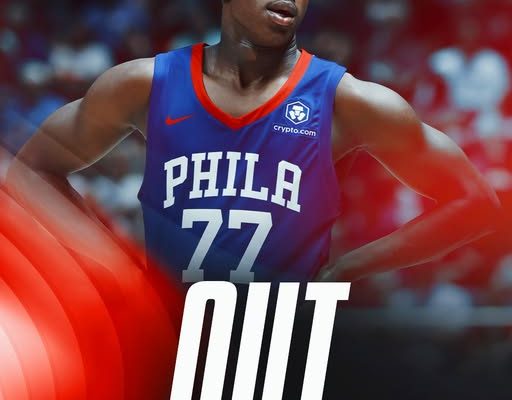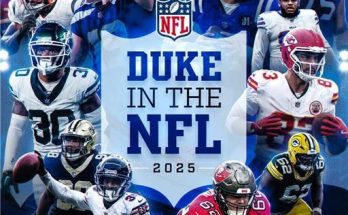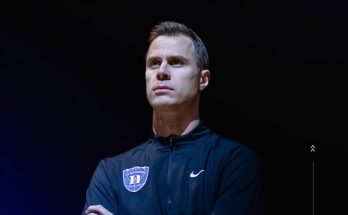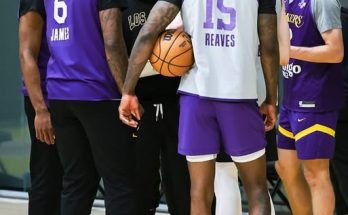The vibrant energy of the NBA Summer League, a crucible for the league’s newest talents and hopefuls, has been momentarily dimmed for the Philadelphia 76ers faithful. News broke recently that VJ Edgecombe, the highly touted No. 3 pick in this year’s draft, has been diagnosed with a left thumb sprain, sidelining him for Thursday’s Summer League game in Las Vegas. While the team has stated the injury is “not considered serious” and he was held out in “an abundance of caution,” with a re-evaluation planned, any setback for a rookie with such high expectations warrants a closer look. This situation offers a valuable opportunity to delve into the intricacies of sports injuries, the significance of the NBA Summer League, and the broader context of rookie development in the high-stakes world of professional basketball.
VJ Edgecombe’s brief but brilliant Summer League debut in Salt Lake City on July 5th had ignited a palpable buzz. Despite the 76ers’ 93-89 loss to the Utah Jazz, Edgecombe’s performance was nothing short of electrifying. He posted a double-double with 28 points, 10 rebounds, four assists, and two blocks. His efficiency, particularly around the rim, was a standout, shooting 13 for 27 from the field. While his 1-for-7 showing from beyond the arc and 1-for-3 from the free-throw line indicated areas for growth, his overall impact and assertive play clearly demonstrated why the Sixers invested their No. 3 overall pick in him. He looked comfortable driving the lane, finishing through contact, and even showcased some promising mid-range jumpers. This impressive outing solidified early confidence in the young Baylor product, who was the 2025 Big 12 Freshman of the Year, leading all conference freshmen in points per game (15.0) and steals per game (2.1). He was also one of only two Division I players last season to record 30 dunks, 50 three-pointers, and 100 free throws, alongside No. 1 pick Cooper Flagg, highlighting his versatile offensive game. The expectation was that he would continue to build on this momentum as the Summer League transitioned to Las Vegas. The thumb sprain, however, has temporarily halted that progression, serving as a reminder of the fragility inherent in high-level athletic competition.
A thumb sprain, in medical terms, refers to an injury to the ligaments surrounding the thumb joint. Ligaments are tough, fibrous tissues that connect bones to other bones, providing stability to joints. A sprain occurs when these ligaments are stretched or torn, typically due to a sudden, forceful motion, such as bending the thumb backward or sideways. In basketball, such injuries can arise from various scenarios: a player falling awkwardly on an outstretched hand, a forceful contact with another player, or even the repeated impact of catching or shooting a basketball. Symptoms commonly include pain, swelling, bruising, and a reduced range of motion or difficulty moving the thumb. The severity of a sprain is typically graded from 1 to 3: a Grade 1 sprain involves stretching of the ligament, a Grade 2 involves a partial tear, and a Grade 3 signifies a complete tear, which may also include an avulsion fracture (where a small piece of bone is pulled away by the ligament). While the 76ers have not specified the grade of Edgecombe’s sprain, the initial assessment of “not serious” and the “abundance of caution” suggests it is likely a Grade 1 or a mild Grade 2 sprain, avoiding the more severe, season-threatening outcomes.
The immediate treatment for a thumb sprain often follows the P.R.I.C.E. principle: Protection, Rest, Ice, Compression, and Elevation. For minor sprains, resting the hand, applying ice, and possibly taping or bracing the thumb to provide support and prevent further injury are common initial steps. The goal is to reduce inflammation and allow the torn or stretched ligament fibers to begin healing. The rehabilitation process, crucial for athletes, progresses from pain and swelling management to restoring range of motion, and then gradually building strength. Exercises such as squeezing a soft ball or rolled sock are often recommended to improve hand and thumb strength. The focus then shifts to sport-specific movements, ensuring the thumb can withstand the demands of passing, dribbling, shooting, and rebounding without re-injury. Return-to-play protocols are meticulously managed by team medical staff, prioritizing the player’s long-term health over immediate gratification. The risk of re-injury, or developing compensatory movements that could lead to other issues, is always a significant concern, especially with delicate joints like the thumb that are so integral to a basketball player’s craft.
The timing of this injury, during Summer League, is both unfortunate and, in some ways, a blessing in disguise. The NBA Summer League is an unofficial proving ground, a crucial developmental stage for rookies and fringe players. It’s where these young athletes get their first taste of professional competition, adapt to the speed and physicality of the NBA game, and begin to integrate into their new teams. For a top-five pick like Edgecombe, Summer League is less about making the roster – his spot is virtually guaranteed – and more about acclimatization, building confidence, showcasing specific skills, and starting to forge chemistry with future teammates. His stellar debut already served that purpose, demonstrating his offensive prowess and competitive fire. Missing additional Summer League games, while disappointing for fans eager to see more, allows the Sixers to be extremely cautious with his recovery. Unlike a regular season injury, there is no immediate pressure for him to return and contribute to winning games. This controlled environment provides an ideal setting for careful rehabilitation, ensuring he is fully healthy and prepared for the rigors of a full NBA season and training camp.
The Philadelphia 76ers, as an organization, have a mixed history with high draft picks and rookie injuries. While the “Process” era famously saw Joel Embiid miss his first two seasons due to foot injuries before blossoming into an MVP, and Ben Simmons sat out his initial year with a foot fracture, these were far more severe and complex issues. A thumb sprain, while impactful in the short term, rarely carries the same long-term implications. The Sixers’ medical and training staff will undoubtedly take a methodical approach to Edgecombe’s recovery, leveraging their expertise and resources to ensure a full and complete return. This includes access to state-of-the-art rehabilitation facilities, specialized therapists, and monitoring technology to track his progress. The team’s commitment to player health is paramount, especially for a foundational piece like Edgecombe, around whom future plans will undoubtedly be built.
Looking at the broader context of rookie injuries in the NBA, it’s a narrative fraught with both cautionary tales and success stories. Some players, like Embiid, overcome significant early setbacks to achieve superstardom. Others find their careers derailed by chronic issues, or the psychological impact of repeated injuries stifles their development. Studies have shown that early sport specialization can sometimes lead to increased overuse injuries in later professional careers, though Edgecombe’s collegiate background at Baylor, while focused on basketball, doesn’t immediately suggest such a risk. More broadly, the NBA is increasingly aware of the importance of load management and comprehensive player wellness programs. Teams invest heavily in sports science, nutrition, and mental health support to mitigate injury risks and optimize athlete performance and longevity. For a young player like Edgecombe, navigating the transition to the professional level, with its increased demands on both body and mind, requires careful guidance. The team will likely implement a personalized development plan for him that accounts for this early setback, integrating his physical recovery with continued skill development and mental preparation.
Beyond the immediate physical recovery, there’s also the psychological impact of an injury on a young athlete. For many, sports are not just a profession but a core part of their identity. The sudden inability to participate can lead to feelings of frustration, isolation, and even anxiety or depression. The fear of re-injury is also a common and significant hurdle that athletes must overcome. The 76ers’ support system, including sports psychologists and player development staff, will play a crucial role in helping Edgecombe navigate these mental challenges, ensuring he remains engaged, confident, and mentally prepared for his eventual return to the court. Maintaining a positive outlook and trusting the rehabilitation process are just as important as the physical exercises themselves.
The 2025 NBA Draft was a pivotal moment for the Philadelphia 76ers, securing the No. 3 overall pick after an injury-riddled season. With Embiid and Tyrese Maxey forming a formidable core, the team aimed to add a talent who could contribute immediately and grow with the franchise. Edgecombe’s selection was a strategic move, complementing the existing backcourt that features Maxey and newly acquired Jared McCain, alongside restricted free agent Quentin Grimes, who is expected to return. The Sixers also picked Johni Broome out of Auburn in the second round, at No. 35 overall, further bolstering their roster with young talent. Edgecombe’s fit within this evolving roster, with his athleticism, scoring ability, and defensive potential, was seen as a seamless one. This thumb sprain, while a minor disruption, does not change the long-term vision. It simply necessitates a temporary detour in his initial integration.
In conclusion, VJ Edgecombe’s left thumb sprain, though minor, serves as a poignant reminder of the inherent risks and unpredictable nature of professional sports. His dazzling Summer League debut offered a tantalizing glimpse into his potential, showcasing the raw talent and competitive spirit that made him the No. 3 overall pick. The Philadelphia 76ers’ cautious approach to his recovery is a testament to their commitment to his long-term health and development, understanding that a strong foundation is crucial for sustained success. As he embarks on his rehabilitation, the focus will be on ensuring a complete healing of the ligament, restoring full range of motion and strength, and addressing any psychological hurdles that may arise. While his absence from the remaining Summer League games is a disappointment for fans and for Edgecombe himself, it’s a necessary step in safeguarding his promising NBA career. The true test of his resilience and the effectiveness of the Sixers’ player development program will be seen not in these fleeting Summer League contests, but in his eventual, healthy, and impactful debut in the regular season. The buzz around VJ Edgecombe remains, merely on a brief, medically-advised pause.



